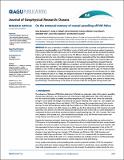Por favor, use este identificador para citar o enlazar a este item:
http://hdl.handle.net/10261/108656COMPARTIR / EXPORTAR:
 SHARE SHARE
 CORE
BASE CORE
BASE
|
|
| Visualizar otros formatos: MARC | Dublin Core | RDF | ORE | MODS | METS | DIDL | DATACITE | |

| Título: | On the temporal memory of coastal upwelling off NW Africa |
Autor: | Benazzouz, Aïssa; Pelegrí, Josep Lluís CSIC ORCID ; Demarcq, Hervé; Machín, Francisco CSIC ORCID; Mason, Evan CSIC ORCID; Orbi, A.; Peña-Izquierdo, Jesús CSIC ORCID; Soumia, Mordane | Palabras clave: | Coastal upwelling Ekman transport NW Africa SST difference Temporal memory Northwest Africa SST |
Fecha de publicación: | sep-2014 | Editor: | American Geophysical Union | Citación: | Journal of Geophysical Research - Part C - Oceans 119(9): 6356–6380 (2014) | Resumen: | We use a combination of satellite, in situ, and numerical data to provide a comprehensive view of the seasonal coastal upwelling cycle off NW Africa in terms of both wind forcing and sea surface temperature (SST) response. Wind forcing is expressed in terms of both instantaneous (local) and time-integrated (nonlocal) indices, and the ocean response is expressed as the SST difference between coastal and offshore waters. The classical local index, the cross-shore Ekman transport, reproduces reasonably well the time-latitude distribution of SST differences but with significant time lags at latitudes higher than Cape Blanc. Two nonlocal indices are examined. One of them, a cumulative index calculated as the backward averaged Ekman transport that provides the highest correlation with SST differences, reproduces well the timing of the SST differences at all latitudes (except near Cape Blanc). The corresponding time lags are close to zero south of Cape Blanc and range between 2 and 4 months at latitudes between Cape Blanc and the southern Gulf of Cadiz. The results are interpreted based on calculations of spatial and temporal auto and cross correlations for wind forcing and SST differences. At temporal scales of 2–3 weeks, the alongshore advection of alongshore momentum compensates for interfacial friction, allowing the upwelling jet and associated frontal system to remain active. We conclude that the coastal jet plays a key role in maintaining the structure of coastal upwelling, even at times of relaxed winds, by introducing a seasonal memory to the system in accordance with the atmospheric-forcing annual cycle | Descripción: | 25 pages, 16 figures, supporting Information http://onlinelibrary.wiley.com/doi/10.1002/2013JC009559/suppinfo | Versión del editor: | https://doi.org/10.1002/2013JC009559 | URI: | http://hdl.handle.net/10261/108656 | DOI: | 10.1002/2013JC009559 | E-ISSN: | 2169-9291 |
| Aparece en las colecciones: | (ICM) Artículos (IMEDEA) Artículos |
Ficheros en este ítem:
| Fichero | Descripción | Tamaño | Formato | |
|---|---|---|---|---|
| Benazzouz_et_al_2014.pdf | 2,76 MB | Adobe PDF |  Visualizar/Abrir |
CORE Recommender
SCOPUSTM
Citations
22
checked on 12-abr-2024
WEB OF SCIENCETM
Citations
20
checked on 25-feb-2024
Page view(s)
304
checked on 17-abr-2024
Download(s)
212
checked on 17-abr-2024
Google ScholarTM
Check
Altmetric
Altmetric
NOTA: Los ítems de Digital.CSIC están protegidos por copyright, con todos los derechos reservados, a menos que se indique lo contrario.
